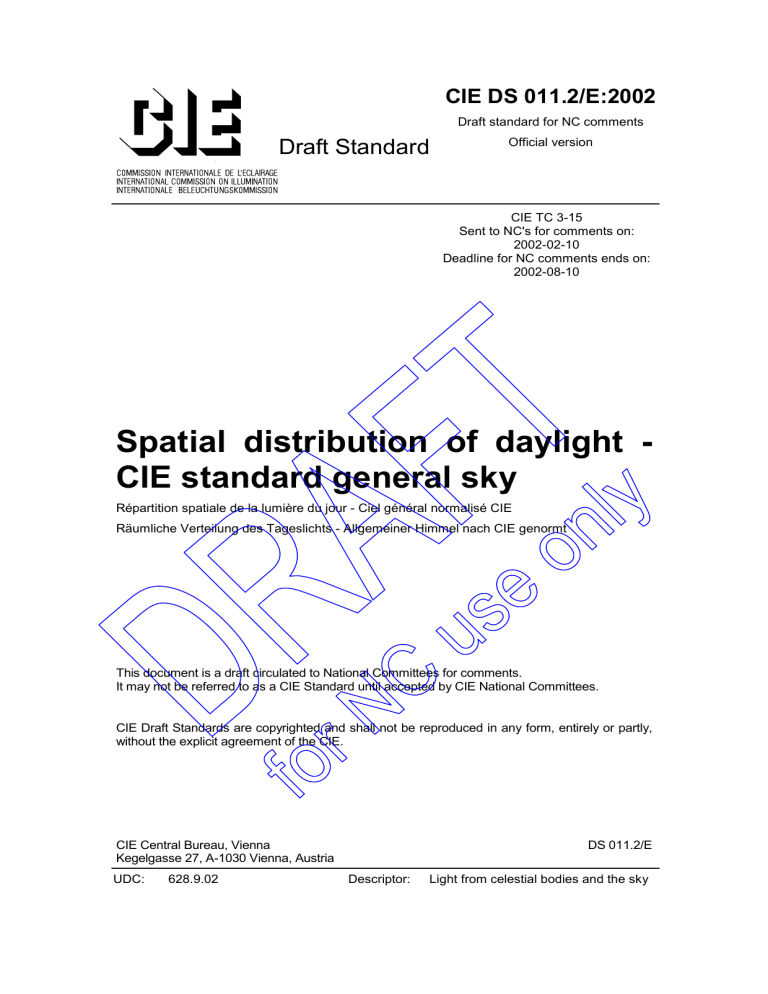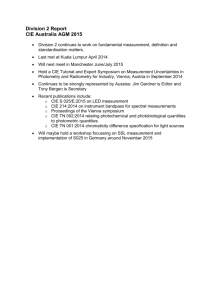
CIE DS 011.2/E:2002
Draft standard for NC comments
Draft Standard
Official version
CIE TC 3-15
Sent to NC's for comments on:
2002-02-10
Deadline for NC comments ends on:
2002-08-10
Spatial distribution of daylight CIE standard general sky
Répartition spatiale de la lumière du jour - Ciel général normalisé CIE
Räumliche Verteilung des Tageslichts - Allgemeiner Himmel nach CIE genormt
This document is a draft circulated to National Committees for comments.
It may not be referred to as a CIE Standard until accepted by CIE National Committees.
CIE Draft Standards are copyrighted and shall not be reproduced in any form, entirely or partly,
without the explicit agreement of the CIE.
CIE Central Bureau, Vienna
Kegelgasse 27, A-1030 Vienna, Austria
UDC:
628.9.02
DS 011.2/E
Descriptor:
Light from celestial bodies and the sky
CIE DS 011.2/E:2002
Copyright notice
This document is a CIE Draft Standard and is copyright-protected by CIE.
Except as permitted under the applicable laws of the user's country, neither
this CIE Draft nor any extract from it may be reproduced, stored in a retrieval
system or transmitted in any form or by any means, electronic, photocopying,
recording or otherwise, without prior written permission being secured.
Requests for permission to reproduce should be addressed to CIE CB:
CIE Central Bureau
Kegelgasse 27
A-1030 Vienna
Austria
Tel.: +43 1 714 3187 0
Fax: +43 1 713 0838 18
e-mail: ciecb@ping.at
Reproduction may be subject to royalty payments or a licensing agreement.
Violators may be prosecuted.
II
Ó CIE, 2002 - All rights reserved
CIE DS 011.2/E:2002
FOREWORD
Standards produced by the Commission Internationale de l’Eclairage are concise documents
on aspects of light and lighting that require a unique definition. They are a primary source of
internationally accepted and agreed data which can be taken, essentially unaltered, into
universal standard systems.
This Standard has been prepared by CIE Technical Committee 3-15*) of Division 3
(Interior Environment and Lighting Design) “Spatial distribution of daylight - CIE standard
general sky “ and was approved by the National Committees of the CIE. This present
standard replaces CIE S003 - 1996 "Spatial distribution of daylight - CIE standard overcast
sky and clear sky".
Table of contents
FOREWORD
III
INTRODUCTION
1
1. SCOPE
1
2. NORMATIVE REFERENCES
1
3. LIST OF SYMBOLS
2
4. SPECIFICATION: THE RELATIVE SKY LUMINANCE DISTRIBUTION
3
5. SPECIFICATION: STANDARD PARAMETERS
3
6. SPECIFICATION: THE TRADITIONAL OVERCAST SKY
6
7. DERIVATION OF THE STANDARD SKY
7
ANNEX A (INFORMATIVE): REFERENCES
7
*) Chairman of this TC was Y. Uetani (JP), members were: S. Aydinli (DE), A. Joukoff (BE),
J. D. Kendrick (AU), R. Kittler (SK), Y. Koga (JP), K. Matsuura (JP), T. Nagata (JP),
H. Nakamura (JP), M. Oki (JP), R. Perez (US), P. R. Tregenza (UK), P. Valko (CH).
Ó CIE, 2002
Ó CIE, 2002- All rights reserved
III
CIE DS 011.2/E:2002
IV
Ó CIE, 2002 - All rights reserved
CIE DS 011.2/E:2002
SPATIAL DISTRIBUTION OF DAYLIGHT - CIE STANDARD GENERAL
SKY
INTRODUCTION
The luminance distribution of the sky depends on weather and climate, and it changes during
the course of a day with the position of the sun. This standard lists a set of luminance
distributions, which model the sky under a wide range of conditions, from the heavily overcast
sky to cloudless weather. It is intended for two purposes:
i.
to be a universal basis for the classification of measured sky luminance distributions
ii.
to give a method for calculating sky luminance in daylighting design procedures.
The Standard defines relative luminance distributions: the luminance of the sky at any
point is given as a function of the zenith luminance. For daylighting calculation purposes it
may be used with values of zenith luminance or of horizontal illuminance to obtain absolute
luminance distributions.
The Standard incorporates both the CIE Standard Clear Sky and the CIE Standard
Overcast Sky, which are treated as a particular cases of the General Sky. The Overcast Sky
is retained as a separate formula because there are many calculation procedures that
embody the mathematical formulation of this particular distribution.
1. SCOPE
This Standard defines a set of outdoor daylight conditions linking sunlight and skylight for
theoretical and practical purposes.
The luminance distributions given have the following characteristics:
i.
They are symmetrical about the solar meridian and are functions of the angular
distance, Zs, between the sun and the zenith.
ii.
They are defined by smooth continuous functions. Such distributions are typical of
cloudless skies and of those where the cloud cover is homogeneous. They provide an
approximation to skies of broken cloud that is sufficiently accurate for many practical
daylight calculation purposes.
iii.
The relative luminance at any point in the sky depends on the angle, c, between that
sky element and the sun, and on the angle, Z, between the sky element and the
zenith. It is given in terms of two functions: the relative scattering indicatrix, f(c), and
the luminance gradation between horizon and zenith, j(Z).
2. NORMATIVE REFERENCES
The following standards contain provisions, which through reference in the text, constitute
provisions of this standard. At the time of publication, the editions indicated were valid. All
standards are subject to revision, and parties to agreements based on the Standard are
encouraged to investigate the possibility of applying the most recent editions of the standards
indicated below. Members of the CIE, IEC and ISO maintain registers of currently valid
international standards.
1. CIE 17.4-1987 International Lighting Vocabulary, ILV (joint publication IEC/CIE).
2. ISO 31:1992 Quantities and Units, Part 6: Light and Related Electromagnetic Radiations.
Ó CIE, 2002 - All rights reserved
1
CIE DS 011.2/E:2002
3. LIST OF SYMBOLS
For the purposes of this Standard, the following symbols apply:
a, b
luminance gradation parameters
a
azimuth of a sky element (clockwise from north) [rad]
as
azimuth of the sun (clockwise from north) [rad]
c, d, e
scattering indicatrix parameters
c
shortest angular distance between a sky element and the sun [rad]
f(c)
scattering indicatrix function
j(Z)
luminance gradation function
g
angle of elevation of a sky element above the horizon [rad]
gs
angle of elevation of the sun above the horizon [rad]
La
luminance of a sky element [cd/m ]
Lz
zenith luminance [cd/m ]
Z
angular distance between a sky element and the zenith [rad]
Zs
angular distance between the sun and zenith [rad]
2
2
For quantities and units see Normative References 1 & 2.
zenith
Zss
Z
sun
c
Z
Z
sky element
ggs
aass
gg
North
a
a
Figure 1. Angles defining the position of the sun and a sky element.
2
Ó CIE, 2002 - All rights reserved
CIE DS 011.2/E:2002
4. SPECIFICATION: THE RELATIVE SKY LUMINANCE DISTRIBUTION
The position of an arbitrary sky element is defined by its zenith angle, Z, and by the azimuth
difference between the element and the sun, |a-as|. If Zs is the zenith angle of the sun, the
angular distance between the element and the sun is
(
c = arccos cos Z s × cos Z + sin Z s × sin Z × cos a - a s
)
(1)
Alternatively, the angle of elevation, g, may be used instead of the zenith angle, Z, to
define the position of an element. Then
Z=
p
-g
2
(2)
Similarly the zenith angle of the sun may be obtained from the solar elevation by
Zs =
p
-gs
2
(3)
The ratio of the luminance, La, of an arbitrary sky element to the zenith luminance, Lz, is
La
f ( c ) × j (Z )
=
Lz f (Z s ) × j (0)
(4)
The luminance gradation function, j, relates the luminance of a sky element to its zenith
angle:
p
æ b ö
j (Z ) = 1 + a × expç
when 0 £ Z <
÷,
2
è cos Z ø
æp ö
j ç ÷ = 1,
at the horizon
è2ø
(5)
The parameters a and b are given in Table 1 for standard sky types.
Equation 4 requires the value at the zenith. This is
j (0) = 1 + a × exp b
(6)
The function f is a scattering indicatrix which relates the relative luminance of a sky element to
its angular distance from the sun:
é
æ p öù
f ( c ) = 1 + c × êexp(dc ) - expç d ÷ú + e × cos2 c
è 2 øû
ë
(7)
Its value at the zenith is
é
æ p öù
f (Zs ) = 1 + c × êexp(dZs ) - expç d ÷ú + e × cos2 Zs
è 2 øû
ë
(8)
5. SPECIFICATION: STANDARD PARAMETERS
For purposes of classification and description, the parameters a to e in equations 5 - 8 shall
be selected from Table 1. This lists fifteen standard relative luminance distributions which are
based on six groups of a and b values for the gradation function and six groups of c, d and e
values for the indicatrix function. The resulting curves are illustrated in Figs. 2 and 3.
Ó CIE, 2002- All rights reserved
3
CIE DS 011.2/E:2002
Table 1. Standard parameters
Type
4
Grada- Indication
trix
group group
a
b
c
d
e
Description of luminance distribution
0
CIE Standard Overcast Sky,
Steep luminance gradation towards
zenith, azimuthal uniformity
1
I
1
4,0
-0,70
0
-1,0
2
I
2
4,0
-0,70
2
-1,5
3
II
1
1,1
-0,8
0
-1,0
0
Overcast, moderately graded with
azimuthal uniformity
4
II
2
1,1
-0,8
2
-1,5
0,15
Overcast, moderately graded and
slight brightening towards the sun
5
III
1
0
-1,0
0
-1,0
0
6
III
2
0
-1,0
2
-1,5
Partly cloudy sky, no gradation
0,15 towards zenith, slight brightening
towards the sun
7
III
3
0
-1,0
5
-2,5
Partly cloudy sky, no gradation
0,30 towards zenith, brighter circumsolar
region
8
III
4
0
-1,0
10
-3,0
0,45
9
IV
2
-1,0 -0,55
2
-1,5
0,15 Partly cloudy, with the obscured sun
10
IV
3
-1,0 -0,55
5
-2,5
0,30
Partly cloudy, with brighter
circumsolar region
11
IV
4
-1,0 -0,55
10
-3,0
0,45
White-blue sky with distinct solar
corona
12
V
4
-1,0 -0,32
10
-3,0
0,45
CIE Standard Clear Sky,
low luminance turbidity
13
V
5
-1,0 -0,32
16
-3,0
0,30
CIE Standard Clear Sky,
polluted atmosphere
14
VI
5
-1,0 -0,15
16
-3,0
0,30
Cloudless turbid sky with broad
solar corona
15
VI
6
-1,0 -0,15
24
-2,8
0,15
White-blue turbid sky with broad
solar corona
Overcast, with steep luminance
0,15 gradation and slight brightening
towards the sun
Sky of uniform luminance
Partly cloudy sky, no gradation
towards zenith, distinct solar corona
Ó CIE, 2002 - All rights reserved
CIE DS 011.2/E:2002
8
VI
5
Relativegradation
gradationf(Z
j(Z)/j(0)
)/f(0)
relative
V
IV
2
III
1
II
0,5
I
0,2
0
30
60
zenith
angle
Z
in
degrees
Zenith angle Z in degrees
90
Figure 2. Standard gradation function groups.
20
6
5
Relative
indicatrixf(c
f(c)
Relative
indicatrix
)
10
4
5
3
2
1
1
0,8
0.8
0
30
60
90
120
150
180
Scattering angle c in degrees
Scattering angle c in degrees
Figure 3. Standard indicatrix function groups.
Ó CIE, 2002- All rights reserved
5
CIE DS 011.2/E:2002
6. SPECIFICATION: THE TRADITIONAL OVERCAST SKY
th
The standard general sky integrates the traditional overcast sky formula as the 16 sky that
may be used as an alternate to Sky Type 1 when only overcast skies are to be modelled. This
luminance distribution should be expressed by the ratio of the luminance of a sky element,
Loc(g), to the zenith luminance, Lzoc:
Loc (g ) 1 + 2 × sin g
=
Lzoc
3
(9)
where g is the angle of elevation of the sky element above the horizon.
The difference between Sky Types 1 and 16 is shown on Fig. 4.
1.0
30%
0.9
Relative Luminance
0.7
10%
0.6
0.5
0%
0.4
-10%
0.3
CIE General Sky: Sky Type 1
0.2
-20%
Traditional Overcast Sky: Sky Type 16
0.1
Relative Diiference [%]
0.0
0
10
20
30
40
50
Relative Diiference [%]
20%
0.8
-30%
60
70
80
90
Angular distance between a sky element and the zenith [deg]
Figure 4. Difference between Sky Types 1 and 16.
6
Ó CIE, 2002 - All rights reserved
CIE DS 011.2/E:2002
7. DERIVATION OF THE STANDARD SKY
The CIE Standard Overcast Sky and the CIE Standard Clear Sky were developed in a series
of publications between 1955 and 1994 [1-4].
The CIE Standard General Sky is a generalisation of the CIE Clear Sky formula [5]. It
has been shown to be a good model of skies with smoothly varying luminous distributions
occurring in various climatic conditions [7,8]. Formulae of this type have also been shown to
provide a good approximation to skies of broken cloud in maritime climates [9,11]. It has also
been shown that approximately four types of the General Sky can give a good
characterisation of the exterior daylight conditions, although the particular sky types may differ
between climates [11].
Absolute values of sky luminance vary with solar elevation, and therefore with
latitude. Empirical equations for zenith luminance and horizontal illuminance have been
published for various climates [6,10,12,13].
ANNEX A (INFORMATIVE): REFERENCES
1. Compte Rendu CIE 13 Session 1955. Natural Daylight. Official Recommendation, 2, part
3.2, II-IV & 35-37 (1955).
2. CIE 22-1973. Standardisation of luminance distribution on clear skies.
3. CIE 110-1994. Spatial distribution of daylight - Luminance distribution of various
reference skies.
4. CIE S 003/E-1996. Spatial distribution of daylight - CIE Standard Overcast Sky and Clear
Sky
5. KITTLER, R., PEREZ, R. and DARULA S. A new generation of sky standards. Proc. Lux
Europa Conf. 359-373 (1997).
6. KITTLER, R. and DARULA, S. Parameterisation problems of the very bright cloudy sky
conditions. Solar Energy, 62 (2), 93-100 (1998).
7. PEREZ, R., SEALS, R., and MICHALSKY, J. All-Weather Model for Sky Luminance
Distribution - Preliminary Configuration and Validation. Solar Energy, 50 (3), 235-245
(1993).
8. KITTLER, R., PEREZ, R. and DARULA, S. A set of standard skies characterising daylight
conditions for computer and energy conscious design. Final Report of the U.S.-Slovak
Grant Project US-SK 92 052. Without appendices published by Polygrafia, Bratislava.
(1998).
9. MATSUZAWA, T., NAKAMURA, H., IGAWA, N. KOGA, Y, GOTO, K. and KOJO, S. Sky
luminance distribution between two CIE Standard Skies (Part 1), Arrangement of the sky
luminance distribution data measured. Proc. Lux Pacifica ’97, Nagoya, Japan, E.7 – E.12
(1997).
10. IGAWA, N., NAKAMURA, H., MATSUZAWA, T., KOGA,Y., GOTO, K. and KOJO, S. Sky
luminance distribution between two CIE Standard Skies (Part 2). Numerical equation for
relative sky luminance distributions. Proc. Lux Pacifica ’97, Nagoya, Japan, E.13 – E.18
(1997).
11. TREGENZA, P. R. Standard skies for maritime climates. Lighting Res. & Technol, 31 (3),
97-106 (1999).
12. KITTLER, R., PEREZ, R. and DARULA, S. Universal models of reference daylight
th
conditions based on new sky standards. In Proc.24 Session of the CIE. CIE 133 - 1999,
Vol.1 Part 1, 243-247.
13. IGAWA, N., NAKAMURA, H. and MATSUURA, K. Sky luminance distribution model for
simulation of daylit environment. Proc. Building Simulation '99, Kyoto, 969-975 (1999).
Ó CIE, 2002- All rights reserved
7
CIE DS 011.2/E:2002
Copies of CIE Publications are available from the National Committees of most CIE member
countries. Purchasers in other countries may obtain them from the CIE Central Bureau,
Kegelgasse 27, A-1030 Wien, Austria.
CIE Central Bureau
Kegelgasse 27
A-1030 Vienna
Austria
Tel.: +43 1 714 3187 0
Fax: +43 1 713 0838 18
e-mail: ciecb@ping.at
WWW: http://www.cie.co.at/cie/
8
Ó CIE, 2002 - All rights reserved




